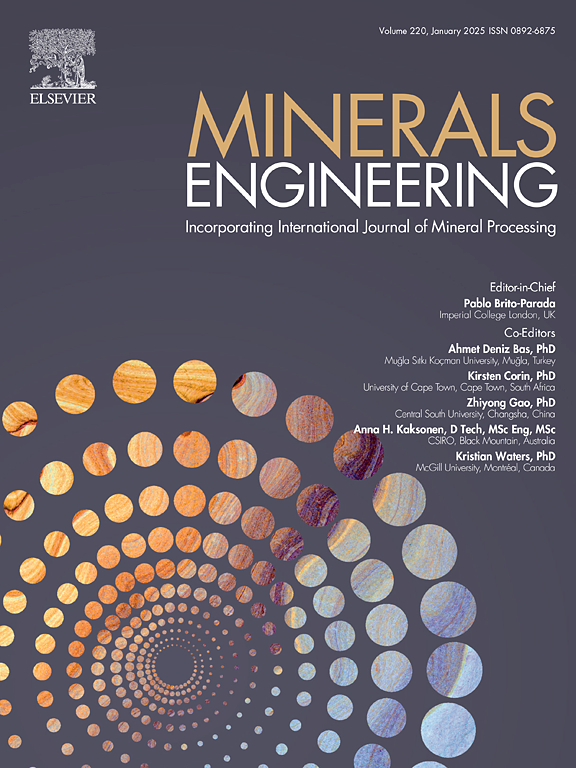从矿物学角度研究波伏瓦花岗岩中锂云石选择性浮选工艺流程
IF 5
2区 工程技术
Q1 ENGINEERING, CHEMICAL
引用次数: 0
摘要
本文介绍了一项初步研究的结果,该研究旨在开发一种流程,以回收来自法国阿列(Allier)的Beauvoir稀有金属花岗岩中的锂和潜在的金属副产品。这种非常规锂矿床的主要挑战之一是粗粒锂云母(~ 300µm)和细粒锂云母(~ 100µm)副产物矿物,即锡石(Sn)、柱长石(Nb)、钽石和微石(Ta)之间的解离网尺寸不同。开发了以锂云母浮选为起点,经猎鹰离心式重选,回收大块重矿物精矿中所有副产物的选矿流程。所有的副产物行为都是用花岗岩中富集程度最高的一种,即锡石进行的。为了达到锂云母的最佳解离,根据薄片上计算的粒度分布(GSD)和不同顶部尺寸(- 500 μ m, - 355 μ m, - 250 μ m和- 177 μ m)的样品进行的自动化矿物学分析,估计了一个理论网格。结果表明,泡沫浮选可有效回收锂云石,当锂云石精矿含量为50%时,可回收78%的锂云石。然而,虽然大多数副产物含矿物在此浮选步骤中报告到尾矿中,但一半的锡石在最细粒度范围(10-177 μ m)的锂云母精矿中被回收。这一问题可能源于本研究通过扫描电镜和自动化矿物学方法发现的锂云石和锡石之间的显著矿物关联。因此,这些结果表明,为了优化从含锂云母的稀有金属花岗岩中回收锡石和其他副产物,首先应进行重选,在中间进料粒度范围内(这里为- 280或- 300µm),以确保锂云母的释放,同时提高所有副产物的回收率。本文章由计算机程序翻译,如有差异,请以英文原文为准。
Flowsheet development for the selective flotation of lepidolite from the Beauvoir granite from mineralogical insights
This paper presents the results of a preliminary study aiming at developing a flowsheet to recover lithium hosted in lepidolite and potential metallic by-products from the Beauvoir rare metal granite (Allier, France). One of the main challenges with such unconventional lithium deposits is the different liberation mesh sizes between the coarse-grained lepidolite (∼300 µm) and the finer-grained (∼100 µm) by-products bearing minerals, namely cassiterite (Sn), columbite (Nb), tantalite and microlite (Ta). A beneficiation flowsheet starting by lepidolite flotation was developed, followed by gravity concentration through Falcon centrifugal separation to recover all by-products in a bulk heavy-minerals concentrate. All by-products behaviours were followed using the most enriched one in the granite, namely cassiterite. To reach an optimal liberation of lepidolite, a theoretical mesh was estimated, both based on grain size distribution (GSD) calculated on thin sections and on automated mineralogy carried out on samples grounded at distinct top sizes (−500 µm, −355 µm, − 250 µm and −177 µm). Results suggest that lepidolite can be effectively recovered using froth flotation with 78 % of lepidolite recovered with a concentrate containing 50 % of lepidolite. However, while most by-products bearing minerals report to the tailings during this flotation step, half of the cassiterite is recovered in the lepidolite concentrate for the finest size ranges (10–177 µm). Such an issue likely stems from the significant mineral association between lepidolite and cassiterite identified in this study trough SEM and automated mineralogy methods. Therefore, these results suggest that, to optimize cassiterite and other by-products recovery from lepidolite-bearing rare metal granites, gravity concentration should be conducted first, with an intermediate feed size range (here −280 or −300 µm) to ensure the liberation of lepidolite while improving the recovery of all by-products.
求助全文
通过发布文献求助,成功后即可免费获取论文全文。
去求助
来源期刊

Minerals Engineering
工程技术-工程:化工
CiteScore
8.70
自引率
18.80%
发文量
519
审稿时长
81 days
期刊介绍:
The purpose of the journal is to provide for the rapid publication of topical papers featuring the latest developments in the allied fields of mineral processing and extractive metallurgy. Its wide ranging coverage of research and practical (operating) topics includes physical separation methods, such as comminution, flotation concentration and dewatering, chemical methods such as bio-, hydro-, and electro-metallurgy, analytical techniques, process control, simulation and instrumentation, and mineralogical aspects of processing. Environmental issues, particularly those pertaining to sustainable development, will also be strongly covered.
 求助内容:
求助内容: 应助结果提醒方式:
应助结果提醒方式:


